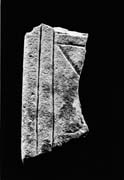Select a site alphabetically from the choices shown in the box below. Alternatively, browse sculptural examples using the Forward/Back buttons.
Chapters for this volume, along with copies of original in-text images, are available here.
Object type: Fragment of stele [1]
Measurements: H. 10.8 cm (4.25 in); W. 4.8 cm (1.8 in); D. 5.3 cm (2.1 in)
Stone type: Fine-grained, white (10YR 8/2) limestone; Hildenley Limestone, Coralline Oolite Formation, Middle Oxfordian, Upper Jurassic; probably reused Roman ashlar, originally from Hildenley, near Malton (see Fig. 5).
Plate numbers in printed volume: 48-51
Corpus volume reference: Vol 3 p. 60
(There may be more views or larger images available for this item. Click on the thumbnail image to view.)
Carving survives on only two faces.
A (broad): The double edge moulding is identical with the one on no. 11, the outer being slightly broader than the inner. A double-incised band crosses horizontally. Below it an incised diagonal drops from the left corner.
D (narrow): Only the double edge moulding remains.
See no. 11.
1. All the pieces from the Minster were discovered as a result of the excavations of 1966-71 by H. Ramm and D. Phillips. They are to be published as a handlist, together with a critical essay, in the forthcoming Royal Commission volume on the excavations. That publication will provide the finer detail of their archaeological contexts, both in a table, and in a description of the excavation of the south transept cemetery.
The following are general references to the stones: Wilson 1978, 142; Hall 1980b, 7, 21; Lang 1988b, 8, 12; Lang 1989, 5.



